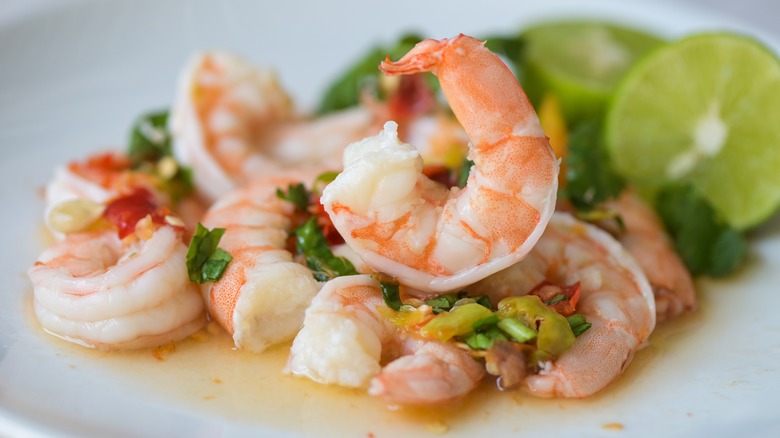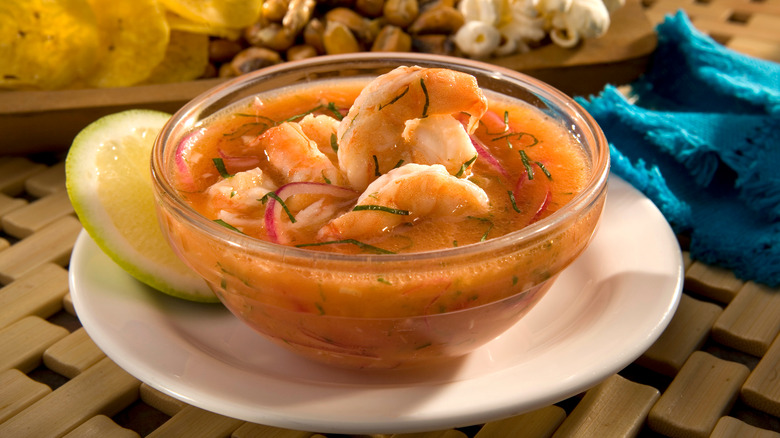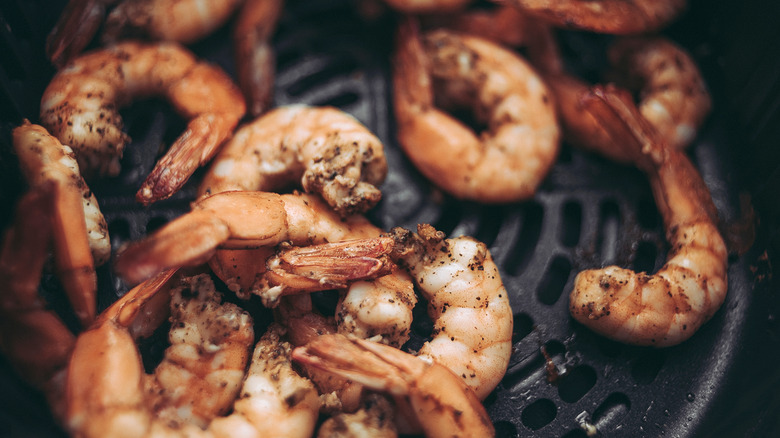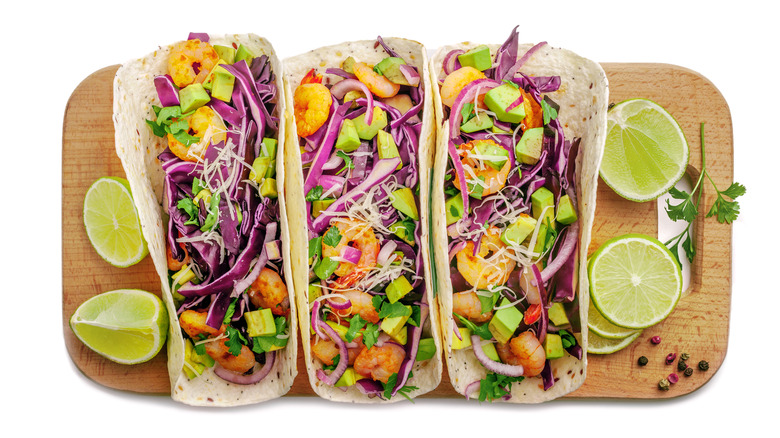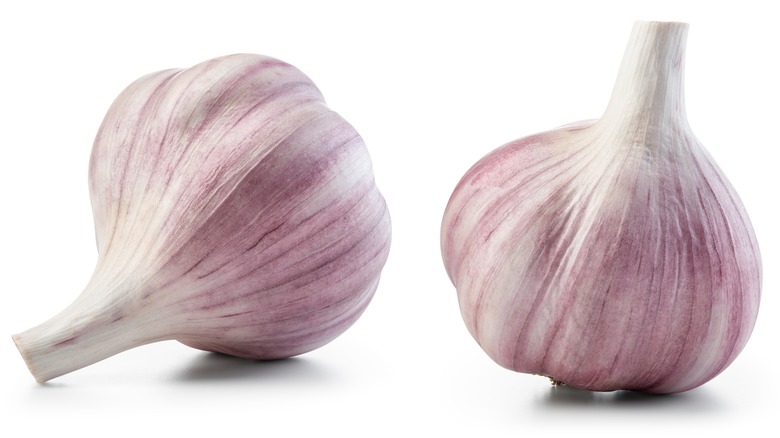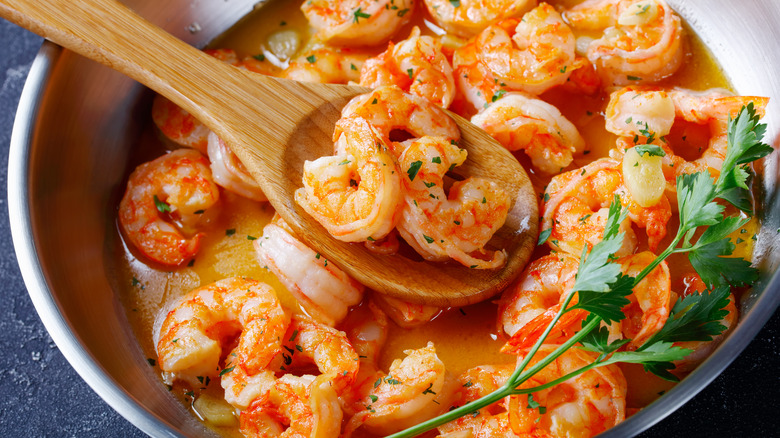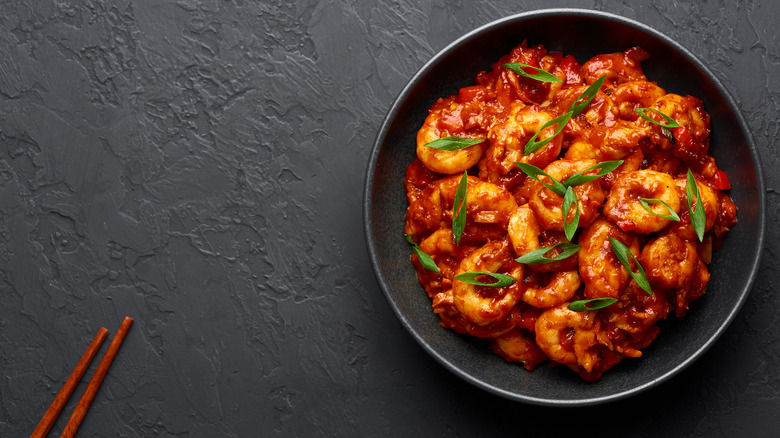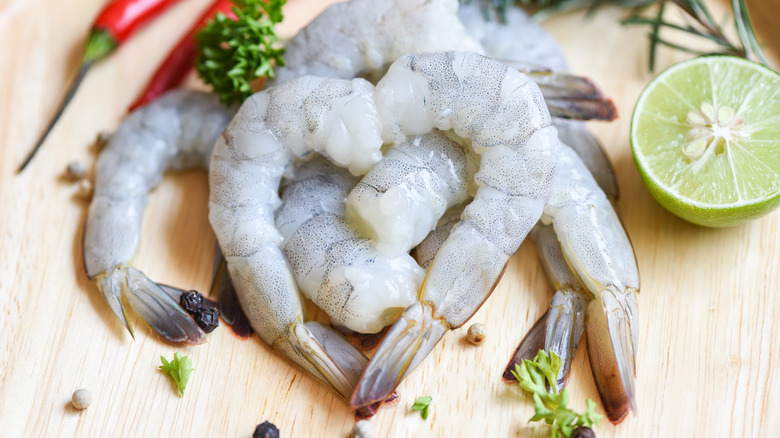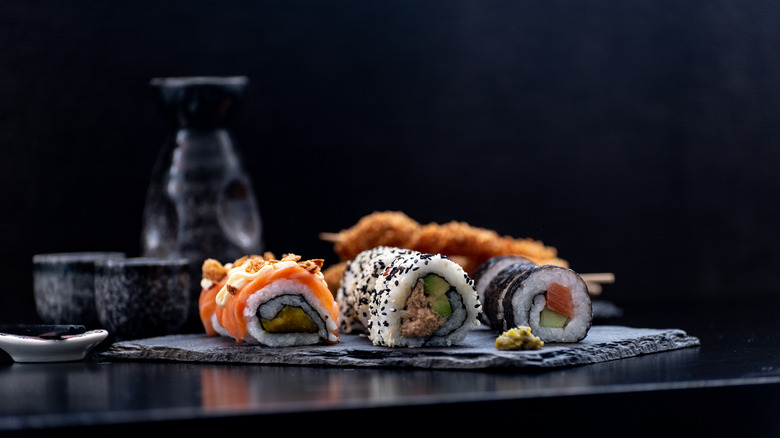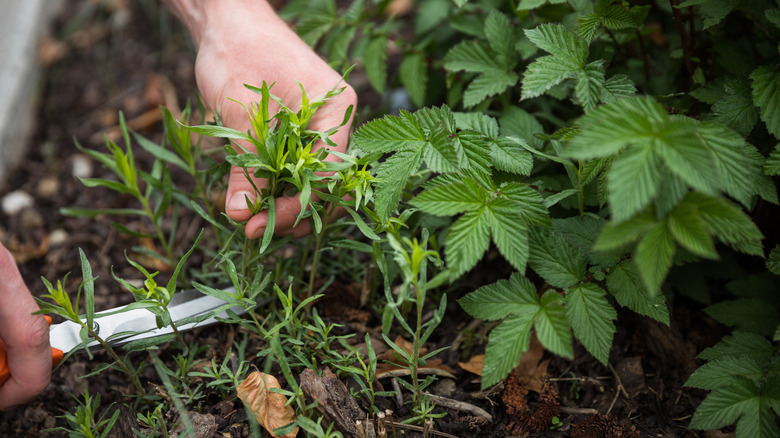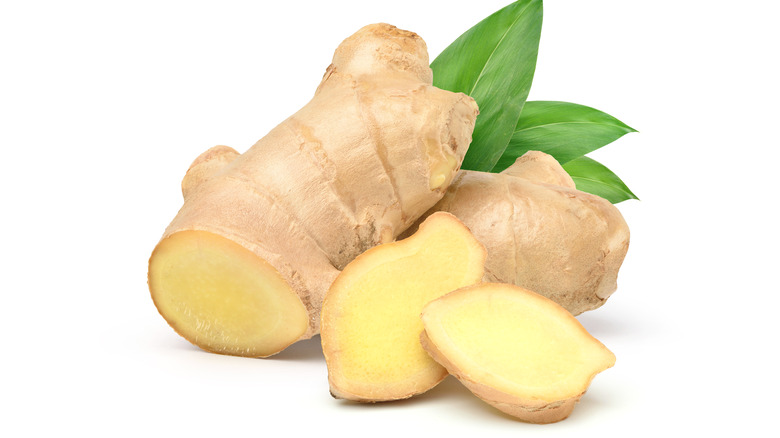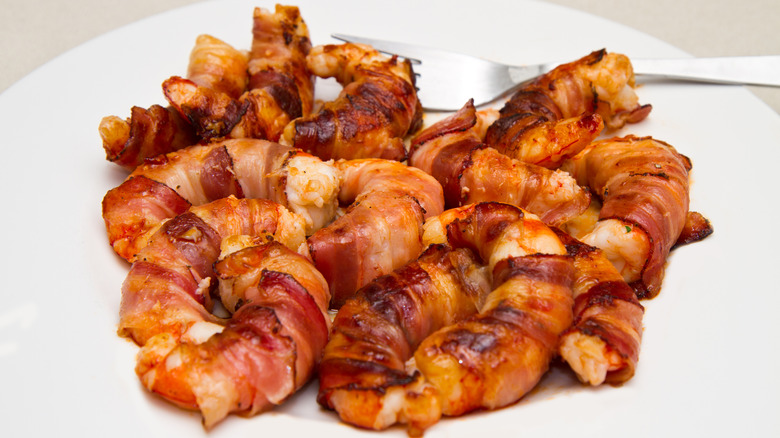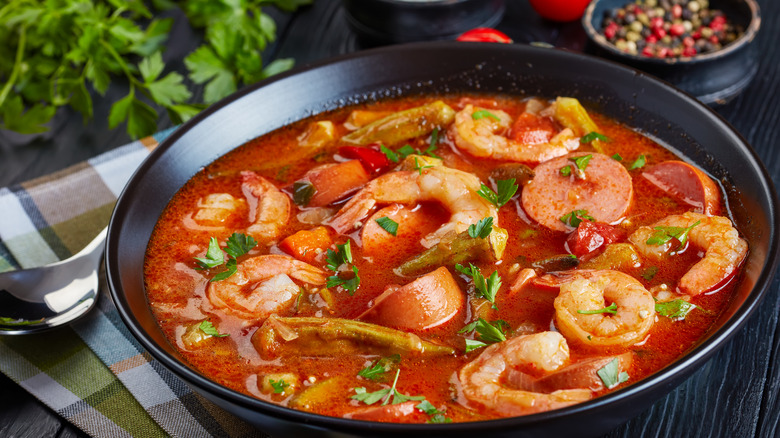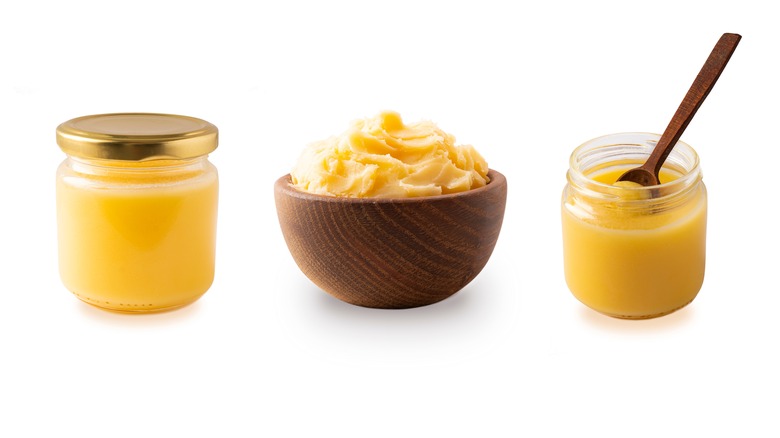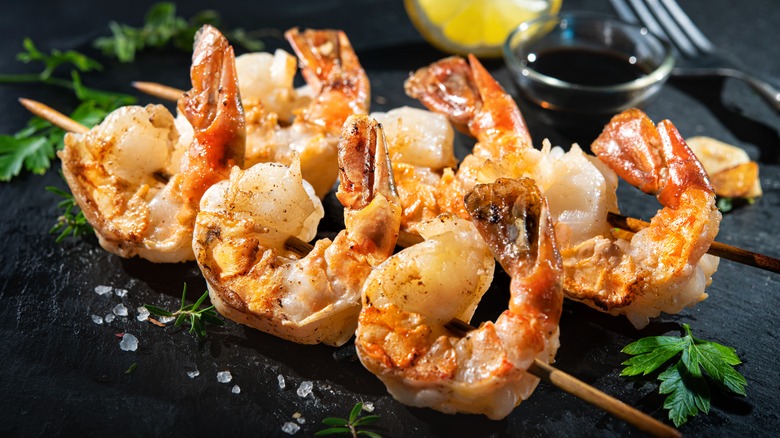15 Ways To Add More Flavor To Shrimp
Shrimp is the new lobster. According to a new survey, this little crustacean has won over the hearts and stomachs of the American public and is the most popular protein at seafood restaurants in the US. And it's no wonder why. Shrimp have a tender, delicate, nutty flavor, they're easy to cook, and they contain a whole host of important vitamins and minerals, including selenium and copper, and they're one of the only sources of carotenoid astaxanthin, which can boost your immune system and help fight inflammation.
Shrimp also has a long history and have been used in recipes from around the world for thousands of years. Since shrimp are found all around the world, coastal communities have incorporated the tender crustacean into all sorts of dishes, like curries, soups, and stir-fries. The ancient Greeks cooked shrimp in fig leaves, while the Romans preferred them fried or roasted. These days, shrimp has evolved as a versatile protein that is used in modern, creative ways to make innovative dishes in kitchens and restaurants around the globe.
On their own, shrimp have a delicate, nutty, mildly sweet flavor, but there are plenty of methods and ingredients that can help elevate the flavor of shrimp to be the star of a meal. The tips and tricks in the list below will show you how.
Marinate your shrimp
When you're cooking shrimp, you want to make sure they're juicy, tender, and full of flavor. Shrimp have a rather mild flavor on their own, so using a marinade can infuse them with herbs and spices that help your shrimp shine. And, when you let your shrimp marinate overnight, the flavors get absorbed into the meat so that they are locked in, maximizing the punch when you take a bite. When you use a marinade that has an acidic component, like vinegar or lemon juice, it helps break down proteins in the shrimp to ensure that they remain tender when they're served.
In fact, one of our favorite shrimp recipes is this souvlaki-style grilled shrimp, which includes lemon juice, oregano, and paprika. Letting the shrimp sit in the marinade ensures that they get evenly coated in herbs and spice, leaving you with shrimp that are consistently flavorful. Marinating can be done ahead of time, so if you're looking to make a quick dinner, pop your shrimp in your marinade the day before and enjoy.
Fry shrimp in an air fryer
It's no secret that air fryers are all the rage these days. An air fryer works by circulating hot air to cook food, so instead of frying shrimp in fat, you can enjoy fried shrimp with a fraction of the calories using little or no oil. This recipe for air fryer spicy shrimp, for instance, doesn't require any oil at all! And you don't need to sacrifice the crisp texture that you get from traditional deep frying because an air fryer can give you the same crunch without the need for the mess that often comes with deep frying shrimp in oil.
Although it has the word "fryer" in the name, some of the best uses for your air fryer have nothing to do with frying at all because the appliance is also capable of grilling, which happens to be another fantastic way to cook flavorful shrimp, as evidenced by this sweet and spicy grilled shrimp recipe. Air fryers also heat much more quickly than conventional ovens, so you can have your shrimp dinner on the table in a fraction of the time.
Incorporate citrus
Did you know that most of the flavor of citrus fruits is contained in the zest? The oils that make lemons and oranges smell so delightfully bright are stored in their skins, and they taste great when they're used to balance out the flavor in a shrimp dish. Shrimp naturally has a low-profile, mildly nutty flavor, which pairs beautifully with the bold tang of fresh citrus zest. And as far as methods, did you know it pays to zest citrus upside-down? This means using the soft side of a grater to get the essential oils of the citrus zest without adding too much bitter pith.
Not only does citrus provide a refreshingly zesty flavor, but it also has an effect on the texture of the shrimp. The acid in citrus helps break down some of the proteins in shrimp, which makes them more tender so that when you bite into one of these tangy crustaceans, you get a perfect mouth feel as well as a pop of flavor. Citrus fruits also contain vitamin C and other beneficial antioxidants, and using them in your shrimp dishes is a delicious way to incorporate citrus into your diet.
Use garlic
One might call garlic shrimp's best friend. While garlic is the pungent cornerstone of cuisines around the world, its robust flavor profile pairs perfectly with shrimp, which is why so many dishes, from this garlic butter shrimp to traditional jambalaya, call for a healthy helping of the odorous tuber. Garlic and shrimp are both versatile and can be used in a variety of different cooking methods, including sauteeing, roasting, and grilling, meaning you can use the pair in a whole host of applications.
Garlic is also low in calories but packs a huge flavor punch, so if you're looking to shed some pounds, you can still feel free to add as much as you'd like. Not only that, but garlic possesses a whole host of health benefits, including reducing cholesterol, blood pressure, and the risk of heart disease. So if you're looking to add a savory, aromatic quality to your shrimp, look no further than the mighty bulb of garlic.
Use wine
Although there's nothing like a glass of wine to complement a tasty meal, sometimes the best way to use wine is in the dish itself. And this definitely proves true when it comes to cooking shrimp. Wine functions in a unique way as a cooking ingredient: Instead of lending its own flavor to a dish, wine helps enhance the flavors of the other ingredients in a dish, which is why you typically cook off all of the alcohol when you use wine in cooking.
The acid in wine not only helps to bring out the flavors of a shrimp dish but the acid in wine helps to tenderize shrimp, which can sometimes turn out tough and rubbery if cooked incorrectly. Wine helps to ensure that you end up with a plate of plump, juicy shrimp every time while adding a signature fragrant aroma that tantalizes the senses when your shrimp is served. It's no wonder that one of the world's most famous shrimp dishes, shrimp scampi, calls for a healthy helping of the fruity, fermented, flavor-enhancing liquid.
Cook shrimp with coconut milk
It's no wonder that coconut and shrimp have been used together in dishes for centuries. In many coastal cultures, like those in the Caribbean and Polynesia, there is an abundance of both sea life and coconuts, so it seems like a no-brainer that these two rich, succulent ingredients would eventually find each other in some delicious ways, like this coconut lime shrimp ceviche. And we should be glad they did because the creamy, slightly sweet taste of coconut milk pairs perfectly with the natural sweetness also found in shrimp, and it's a match made in heaven.
The velvety smooth texture of coconut milk makes it a key ingredient in curries, stews, and soups, which are perfect dishes in which to incorporate tender, succulent shrimp. Coconut milk is also a source of healthy fats, which is why it has gotten a lot of buzz in health food circles recently. If you've never cooked with it, there are some tips you need when cooking with coconut milk, including always shaking the can before you open it and knowing the difference between light, full fat, and coconut cream. So go coco-crazy!
Kick it up a notch
Cajun cuisine doesn't skimp on the spice or on the shrimp. Shrimp has a special place in Cajun cooking, where it often takes center stage in a number of famously fiery dishes like jambalaya, a rice-based dish, and gumbo, a thick soup with okra and sausage. That's because the union of shrimp and spice is divinely delicious. Shrimp are naturally a tad sweet, and adding a vinegar-based hot sauce can cut the sweetness and add a tangy bite to finish off the flavor of your favorite shrimp dish.
Another way to add spice to your shrimp is to use chili flakes or Aleppo pepper, like this drunken shrimp recipe, which takes advantage of shrimp's natural flavors to deliver a spicy, zesty final product. Using hot sauce or chili flakes to finish a shrimp dish also allows diners to customize their own level of spiciness to their liking. After all, some like it hot!
Butterfly the shrimp
Butterflying shrimp is a technique that involves slicing shrimp down the back, cutting it almost all the way through, and then opening it up like a book, as seen in this video by Emeril Lagasse. The top tip you need to butterfly shrimp is to choose large or jumbo-sized shrimp with the shell on because using small shrimp makes the process much more time-consuming. Butterflying your shrimp increases their surface area, so it leaves more meat exposed to soak up all the flavor of your seasoning or from a grill.
Since butterflied shrimp have more surface area to interact with heat when cooking, they cook faster than whole shrimp, and it's easier to cook the meat more evenly. Butterflied shrimp also make for a more attractive presentation, the symmetrical halves giving diners the (correct) feeling that you've worked extra hard to give your shrimp that extra something that elevates the dish. You can also stuff butterflied shrimp with filling like cheese or crab for a delicious and easy-to-eat appetizer.
Add soy sauce
When it comes to shrimp, there are infinite ways to add more flavor, but virtually every shrimp dish calls for salt in some form. Instead of using regular salt, you can use soy sauce, depending on the recipe, to add a more complex flavor profile to your shrimp. Soy sauce has a naturally rich, umami taste that lends itself perfectly to the nutty sweetness of shrimp. It also pairs well with ginger and garlic and is great for Asian-style dishes like this classic shrimp fried rice. Not only can you add soy sauce while cooking, but it can also make a great addition to dipping sauces.
There are many different types of soy sauce to choose from, especially at specialty grocery stores, and each one offers a slightly different taste, be it sweeter, nuttier, or more mellow. Also, if you're looking to limit your sodium intake, a recent study showed that replacing table salt with naturally brewed soy sauce produced the same flavor intensity as salt with less sodium intake.
Finish with fresh herbs
Few ingredients brighten a dish as simply and effectively as fresh herbs. Parsley, for instance, has a fresh, lemony flavor that perfectly complements the rich sweetness of shrimp meat, while rosemary lends a woody, earthy tone that goes well with shrimp on the grill. In this video, Ina Garten, the reigning queen of tasteful entertaining, explains that she likes to add fresh dill to her shrimp salad to give it a fresh tang that cuts through the fat in the dish.
Adding fresh herbs is also a perfect way to get some vitamins, minerals, and antioxidants. According to one study, the oil found in parsley leaves contains a compound that can help ward off cancer, while another study found that thyme may contain antimicrobial properties. And if you don't have an herb garden like Ina Garten, you can store fresh herbs in a refrigerator.
Cook with ginger
Shrimp are commonly found in Asian cuisines. Thai, Vietnamese, and Chinese restaurants often have several shrimp options on their menus that include curries, soups, and stir-fry dishes, where another key ingredient is frequently employed: ginger. The ginger root is native to Southeast Asia and has been used in the local cuisines there for centuries. It has a strong, distinct, pungent flavor that tastes great with the subtle sweetness found in shrimp meat. Asian-inspired dishes like this Vietnamese shrimp salad with ginger or this caramelized shrimp are stellar ways to incorporate the flavorful root into a unique and impressive meal.
And you should be looking to eat more ginger, not just for its robust flavor but for its health benefits. The root has been used for centuries in Asia as a medicine, a practice that has been corroborated by researchers in recent years to reveal that the compounds in ginger can help with nausea, bloating, gas, and even cell damage caused by free radicals (via John Hopkins Medicine).
Add bacon
It's hard to find food that doesn't pair well with bacon. And good news for seafood lovers: Shrimp is no exception. The almost miraculous combination of fatty and salty flavors from bacon pairs perfectly with the delicate, nutty sweetness of shrimp to produce a perfect harmony of flavor and texture. Even a recipe as simple as bacon-wrapped shrimp is sure to satisfy even the pickiest diners. While these bite-size morsels make a great appetizer, you can also put them in a portion of pasta for a heartier main course.
And it's not only a question of flavor. Bacon that's fried crispy provides a contrast in texture to a plump, tender, juicy shrimp, which makes for a more complex and satisfying dining experience. Shrimp are also easily overcooked and can become tough and rubbery, but the fat in bacon helps to keep shrimp moist and tender. You can also add bacon to shrimp recipes, like this authentic shrimp mofongo that contains chopped up bacon that adds a savory, umami profile to the hearty dish.
Serve in a sauce
Nobody said cooking the perfect shrimp was easy. But with a perfectly paired sauce, it's hard to go wrong. Using a sauce helps to ensure that your shrimp don't taste dry when they're served because a creamy curry or a spicy tomato sauce provides some added moisture. Not only that, but the colors and textures in a sauce can make shrimp more visually appealing, and we eat with our eyes first.
Shrimp is one of the fastest-cooking foods you can buy, and they're also easier to work with than fish because they don't fall apart while they're cooking. If you're tight on time and you have a sauce prepared already, you can simply throw the shrimp in the sauce and cook them all together. This ends up being faster than the classic way of cooking shrimp, which involves boiling them separately from a sauce and then mixing them together at the end. So get saucy!
Use butter
As Julia Child famously said: Everything is better with butter. Shrimp, especially when they're fresh and juicy, have a distinct natural flavor that is sometimes overshadowed by other ingredients. But the simple combination of shrimp, butter, and Old Bay seasoning, like the one used in this seafood boil recipe, lets the shrimp shine in the culinary limelight. Butter acts as a taste enhancer, carrying the flavors of other ingredients and delivering them to your taste buds along with the fatty texture and aroma of the butter itself.
The high-fat content in butter also helps to prevent shrimp from drying out during the cooking process. You can poach shrimp in a butter sauce, which is a quick way to cook up a plate of shrimp that won't disappoint. Although butter gets a bad reputation for being a fatty food, it also contains essential vitamins that aid in skin health and bone growth, as well as calcium, which protects from osteoporosis (via WebMD).
Fire up the grill
If you're looking for a rich, smoky flavor, grilling your shrimp is the way to go. When you're grilling shrimp, it's a good idea to go for the jumbo size version because they retain their juicy meat while the outside gets a charred finish that complements the tender shrimp meat. You may also want to put the shrimp on skewers so that they don't fall through the grates on the grill. If you're already firing up the grill to make steak, adding shrimp on the side can make for an opulent, delicious surf and turf-dinner combo. You can also take your smoky grilled shrimp and use them in other creative ways, like this grilled shrimp summer salad.
Grilling shrimp is also one of the healthiest ways to cook crustaceans. Unlike frying and sautéing, grilled shrimp drip off excess fat while they're cooking instead of absorbing it, leaving you with a lean finished product that doesn't require much else to deliver a delectable appetizer or main course.
